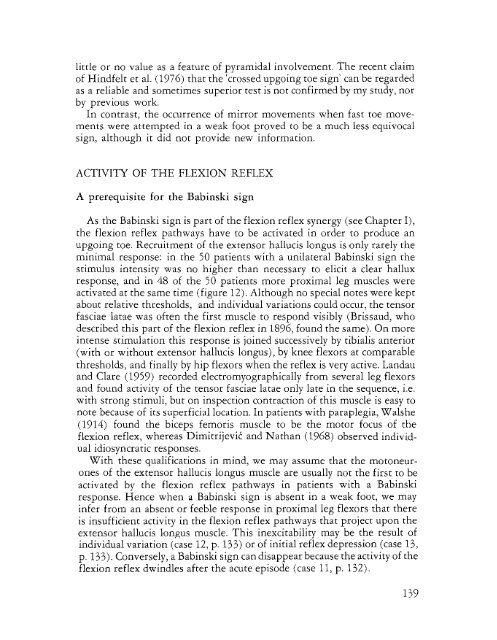You also want an ePaper? Increase the reach of your titles
YUMPU automatically turns print PDFs into web optimized ePapers that Google loves.
little or no value as a feature of pyramidal involvement. The recent claim<br />
of Hindfelt et al. (1976) that the 'crossed upgoing toe sign' can be regarded<br />
as a reliable and sometimes superior test is not confirmed by my study, nor<br />
by previous work.<br />
In contrast, the occurrence of mirror movements when fast toe movements<br />
were attempted in a weak foot proved to be a much less equivocal<br />
sign, although it did not provide new information.<br />
ACTIVITY OF <strong>THE</strong> FLEXION <strong>REFLEX</strong><br />
A prerequisite for the Babinski sign<br />
As the Babinski sign is part of the flexion reflex synergy (see Chapter I),<br />
the flexion reflex pathways have to be activated in order to produce an<br />
upgoing toe. Recruitment of the extensor hallucis longus is only rarely the<br />
minimal response: in the SO patients with a unilateral Babinski sign the<br />
stimulus intensity was no higher than necessary to elicit a clear hallux<br />
response, and in 48 of the SO patients more proximal leg muscles were<br />
activated at the same time (figure 12). Although no special notes were kept<br />
about relative thresholds, and individual variations could occur, the tensor<br />
fasciae latae was often the first muscle to respond visibly (Brissaud, who<br />
described this part of the flexion reflex in 1896, found the same). On more<br />
intense stimulation this response is joined successively by tibialis anterior<br />
(with or without extensor hallucis longus), by knee flexors at comparable<br />
thresholds, and finally by hip flexors when the reflex is very active. Landau<br />
and Clare ( 19S9) recorded electromyographically from several leg flexors<br />
and found activity of the tensor fasciae latae only late in the sequence, i.e.<br />
with strong stimuli, but on inspection contraction of this muscle is easy to<br />
note because of its superficial location. In patients with paraplegia, Walshe<br />
(1914) found the biceps femoris muscle to be the motor focus of the<br />
flexion reflex, whereas Dimitrijevic and Nathan (1968) observed individual<br />
idiosyncratic responses.<br />
With these qualifications in mind, we may assume that the motoneurones<br />
of the extensor hallucis longus muscle are usually not the first to be<br />
activated by the flexion reflex pathways in patients with a Babinski<br />
response. Hence when a Babinski sign is absent in a weak foot, we may<br />
infer from an absent or feeble response in proximal leg flexors that there<br />
is insufficient activity in the flexion reflex pathways that project upon the<br />
extensor hallucis longus muscle. This inexcitability may be the result of<br />
individual variation (case 12, p. 133) or of initial reflex depression (case 13,<br />
p. 133 ). Conversely, a Babinski sign can disappear because the activity of the<br />
flexion reflex dwindles after the acute episode (case 11, p. 132).<br />
139
















